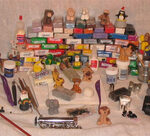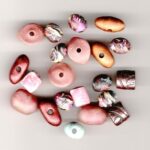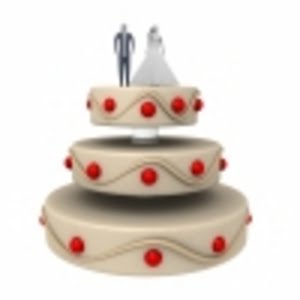Do you have an image on paper that you wish you could put on polymer clay? Maybe you want to personalize something you’re making as a gift, or maybe you’d like to preserve your child’s latest work of art. Well, there is a way to get that image onto clay, with a process called transferring.
To begin, you must have an image made with a medium that will transfer. Ordinary magazine and book pages won’t and, unfortunately, neither will images printed by an inkjet printer. Words or drawings made with an oil- or wax-based medium, like crayons, most (but not all) colored pencils, and oil pastels will transfer, as will laser-printed images. But even if the original is made this way, you may not want to use it, because the transfer process will destroy it.
What’s the answer, then? Laser prints will work, because they’re made with a dry toner process, and your original will be preserved in digital form on your hard drive. If laser printing is not an option, then your local copy center is probably the best choice. Just make sure your copies are made with a machine that uses dry ink toner, not some other technology.
Once you have the original you intend to transfer you’ll need to prepare the clay. A smooth surface is best for this technique; textures will distort the image or prevent parts of it from transferring (which can create a whole different effect – but maybe not the one you want!). You’ll probably find that a light color of clay works best, but that will depend on the colors in the original.
Place the original face down on the surface of the clay and press on it (artists call this “burnishing”) to be sure it makes even contact with the surface of the clay. Make sure you get rid of any air bubbles; the image won’t transfer in these areas. At this stage your image may transfer to the clay all by itself, without any other work on your part, except to remove the paper before curing. If it doesn’t, you have two other options – heat and alcohol.
If you’re using a heat transfer process your next step is trim the clay to the size you want and then cure it as usual. After it’s come out of the oven and cooled, remove the paper. Then you can add edges and other embellishments and rebake if necessary, or just use the object the way it is.
If you’re using alcohol the transfer is done before curing. Once the original is pressed into the clay drop a little alcohol onto the back of the paper and start rubbing, slowly and gently. The alcohol will loosen the paper, turning it back into the fiber it was originally, and the paper will start to ball up and peel away under your finger. The paper needs to stay wet for this to work; if it starts to dry out re-wet it with plain water, not more alcohol. This may seem like a slow process, but it won’t take that long, especially if your image is small. Once the paper is completely gone you should see your image on the surface of the clay, and you can finish the piece however you like.
You may be wondering what kind of alcohol to use. Many people use rubbing alcohol, which is certainly easy to obtain and reasonably priced. But some polymer clay artists prefer gin. It’s more expensive, of course, but at least you won’t use much, and some people think that cheap gin works the best!
A final note: It’s very important to remember that, just as with a rubber stamp, the transfer will be a reverse copy of the original. If you have an original that contains letters or words the final version won’t be readable. If there are no letters on your original or if it looks fine backwards this may not be an issue for you. If it is, you’ll need to have the copy center print a reversed version, so it will transfer to the clay facing the right direction.
Transfers are just one more way to get creative with polymer clay. But they can open up all kinds of new possibilities because they give you a way to “exhibit” other art forms in clay.
——————————————
Additional source: “Coloring Book Beads” by Marie Segal, Polymer Cafe, Fall 2005, pp. 32-33.




